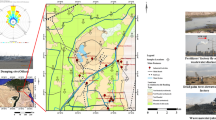Features of the distribution of native (40K, 226Ra, 232Th) and artificial (90Sr, 137Cs) radionuclides in the soil of two different biotopes – beneath a vertical cliff colony of seabirds and on a gentle slope with a typical arctic tundra – were investigated. The investigations were performed in June 2018 in the vicinity of the Russian village of Barentsburg and Kolesbukhta Bay (Svalbard Archipelago). The specific activity of 90Sr and 137Cs in the soil of the Arctic tundra was significantly higher than in the soil beneath the bird colony. The specific activity of native radionuclides in the ornithogenic soil beneath the bird colony correlated positively: 40K and 226Ra, 40K and 232Th, 226Ra and 232Th. A moderate positive interrelation was noted between the content of 137Cs in the soil beneath the bird colony and the height above sea level. The 137Cs distribution beneath the bird colony testifies in support of the mechanism whereby this radionuclide is removed from the marine ecosystem.
Similar content being viewed by others
References
E. Førland, R. Benestad, I. Hanssen-Bauer, et al., “Temperature and precipitation development at Svalbard 1900–2100,” Ad. Meteor. (2011), doi:https://doi.org/10.1155/2011/893790.
P. Kershaw, D. McCubbin, and K. Leonard, “Continuing contamination of north Atlantic and Arctic waters by Sellafield radionuclides,” Sci. Total Environ., 237, 119–132 (1999).
D. Matishov and G. Matishov, Radioecology in Northern European Seas, Springer Verlag, Berlin (2004).
A. G. Grigor’ev, E. N. Nesterova, I. A. Neevin, and M. A. Kholmyanskii, “Scheme of the technogenic radioactive contamination of the Russian Arctic,” Probl. Arkt. Antarkt., No. 4, 16–22 (2017).
D. Huang, T. Yu, H. Bao, et al., “Vertical profiles of 90Sr activities in seawater in the Greenland Sea, Chukchi Sea, and Arctic Ocean,” Marine Poll. Bul., 141, 299–306 (2019).
G. G. Matishov, D. G. Matishov, E. Shchipa, and K. Rissanen, Radionuclides in the Ecosystem of the Barents and Kara Seas Region, KSC RAS, Apatity (1994).
M. Dowdall, J. Gwynn, G. Gabrielsen, and B. Lind, “Assessment of elevated radionuclide levels in soils associated with an avian colony in a high arctic environment,” Soil Sediment. Contam., 14, No. 1, 1–11 (2005).
M. Dowdall, J. Gwynn, C. Moran, et al., “Organic soil as a radionuclide sink in a High Arctic environment,” J. Radioan. Nucl. Chem., 266, No. 2, 217–223 (2005).
S. Kristiansen, H. Leinaas, D. Herzke, et al., “Seabird-transported contaminants are reflected in the Arctic tundra, but not in its soil-dwelling springtails (Collembola),” Environ. Sci. Technol., 53, No. 21, 12835–12845 (2019).
N. V. Lebedeva, A. A. Taskaeva, E. N. Melekhina, and E. P. Zazovskaya, “Invertebrates in a gradient of soils of different ages under a seabird colony in the Grenfjord area (Svalbard, Arctic),” Kavkaz. Entomol. Byull., 16 No. 2, 283–294 (2020).
Methodology for Measuring the Specific Activity of Strontium-90 in Environmental Samples Using an LS6500 Scintillation Unit, MMBI KSC RAS, FGUP NPO Khlopin Radium Institute, Murmansk (2015).
Methodology for Measuring the Activity (specific activity) of Gamma-Emitting Radionuclides in Counting Samples Using the CANBERRA Gamma-Ray Energy Spectrometer with GENIE-2000 Software, MMBI KSC RAS, STC RADEK, Murmansk (2015).
S. Holmes and W. Huber, Modern Statistics for Modern Biology, Cambridge University Press, Cambridge, United Kingdom (2019).
M. Dowdall, J. Gwynn, C. Moran, et al., “Uptake of radionuclides by vegetation at a High Arctic location,” Environ. Roll., 133, No. 2, 327–332 (2005).
J. Gwynn, M. Dowdall, C. Davids, et al., “The radiological environment of Svalbard,” Polar Res., 23, No. 2, 167–180 (2004).
Author information
Authors and Affiliations
Corresponding author
Additional information
Translated from Atomnaya Énergiya, Vol. 131, No. 4, pp. 219–223, October, 2021.
Rights and permissions
About this article
Cite this article
Lebedeva, N.V., Usyagina, I.S. & Valuyskaya, D.A. Radionuclides in the Soil of Typical Arctic Tundra and Beneath a Bird Colony Near the Russian Village of Barentsburg (Svalbard Archipelago). At Energy 131, 219–224 (2022). https://doi.org/10.1007/s10512-022-00870-8
Received:
Published:
Issue Date:
DOI: https://doi.org/10.1007/s10512-022-00870-8




